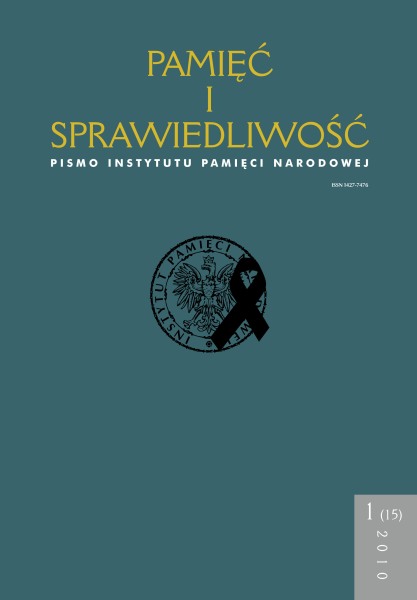Zimnowojenna emigracja polityczna jako przedmiot badań
Pamięć i Sprawiedliwość, Tom 15 Nr 1 (2010), strony: 57-71
Data publikacji: 2010-06-30
Abstrakt
Researches in the field of the 20th century migration, achieved particular level, however an attempt of the overall look at the phenomenon of the political emigration in Central Europe, starting from II World War until transformations of years 1989–1991, is still required. In postwar Poland, it was allowed to write about the political emigration, identified until 1989 as a threat, either in secret papers intended for security service and for a small group of decision makers, or in publications which main purpose was to diminish the very idea of the emigration, or – after some time – in studies aimed to show the emigration only as a one out of many human communities, with no political beliefs and what is more – hostile to the political system of socialist states. In 1990s, two major synthesis of the history of the polish emigration were published: Materiały do dziejów uchodźstwa niepodległościowego [Materials for the history of the independence emigration] (London) and Druga Wielka Emigracja [The Second Great Emigration] (Warsaw). During the following decade several
crucial works that extend, complement or revise the findings concerning the functioning of the parliamentarism in exile, the party system, important people’s life, day-to-day problems, as well as contacts between emigrants and Poland, appeared.
Furthermore the opening of the former secret services’ archives delivered new types of sources to conduct researches on the history of the emigration. In addition to this, the development of research using sociological methods to study the phenomenon of the political emigration is also considered to have been an
important achievement. The result of previous researches – mentioned above – should be treated as a good starting point to the next trail of making a synthesis of the history of the Polish emigration and also as a possibility to create a wider program of study the history of emigration during the Cold War. While concentrating on the 20th century processes of migration reveals the structure and the scale of people’s displacements, there is still a real necessity for the characteristic Cold War-migration
to be focused on from the political reasons – the analysis of knowingly conducted state’s policies. Therefore, undertaking a study of this phenomenon seems to be essential to understand the undercurrent of the Cold War. Seeing that, it is important to confront with each other at least three perspectives – the Communist bloc countries, the countries of resettlement and the emigrants themselves. What is more, the synthesis of the history of the 1939–1991 Central Europe emigration is highly required to be published.
Inne teksty tego samego autora
- Sławomir Łukasiewicz, Paweł Machcewicz, Paweł Sasanka, Paweł Ziętara, Rok 1956 - 60 lat później. Dyskusja z udziałem Sławomira Łukasiewicza, Pawła Machcewicza, Pawła Sasanki, Pawła Ziętary , Pamięć i Sprawiedliwość: Tom 28 Nr 2 (2016)
- Sławomir Łukasiewicz, Federacja jako zagrożenie. Działania wywiadu PRL wobec polskich federalistów na Zachodzie po drugiej wojnie światowej , Pamięć i Sprawiedliwość: Tom 12 Nr 1 (2008)
- Sławomir Łukasiewicz, Aparat bezpieczeństwa PRL o polskich federalistach , Pamięć i Sprawiedliwość: Tom 12 Nr 1 (2008)
- Sławomir Łukasiewicz, [Recenzja] Artur Trudzik, Polski Ruch Wolnościowy „Niepodległość i Demokracja” i jego organ prasowy „Trybuna”. Dzieje ruchu, periodyku i innych czasopism wydawanych przez PRW „NiD”, Warszawa 2009 , Pamięć i Sprawiedliwość: Tom 16 Nr 2 (2010)
- Sławomir Łukasiewicz, Partia, ideologia i wywiad polityczny. Studium funkcjonowania organizacji partyjnej w wywiadzie Ministerstwa Bezpieczeństwa Publicznego , Pamięć i Sprawiedliwość: Tom 23 Nr 1 (2014)
- Sławomir Łukasiewicz, Przesłuchania generała Modelskiego przed komisjami Izby Reprezentantów i Senatu USA wiosną 1949 roku , Pamięć i Sprawiedliwość: Tom 15 Nr 1 (2010)
 Język Polski
Język Polski
 English
English
 Deutsch
Deutsch
 Français (France)
Français (France)
 Italiano
Italiano
 Русский
Русский


 PDF
PDF
